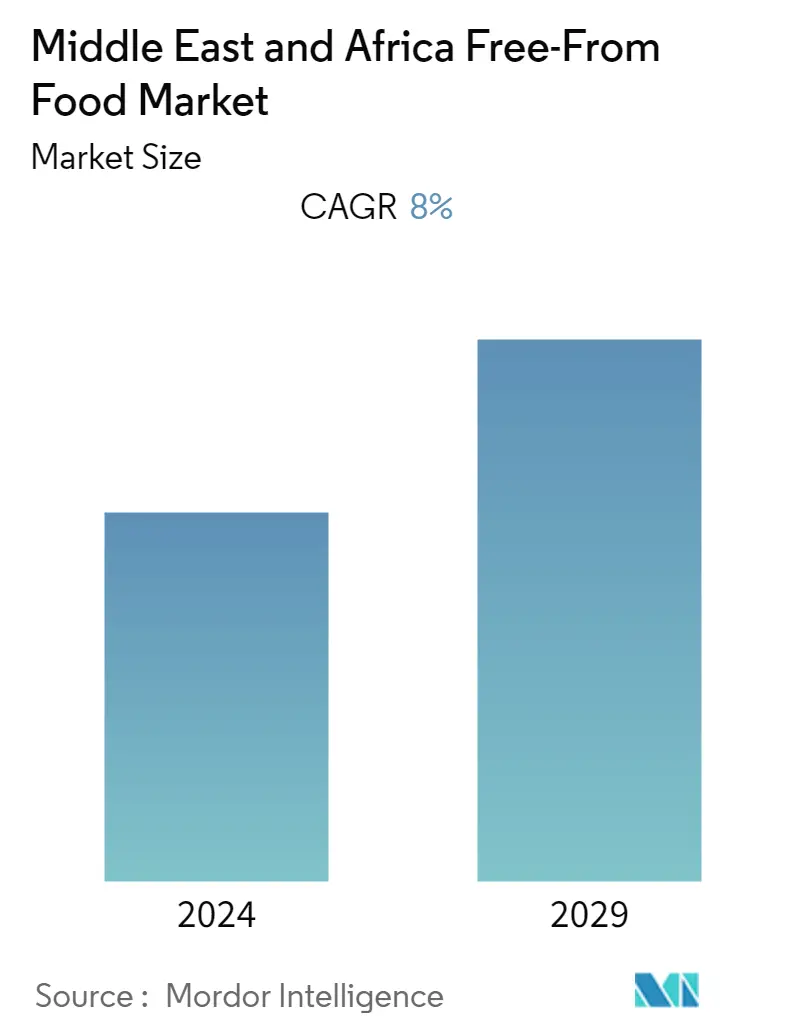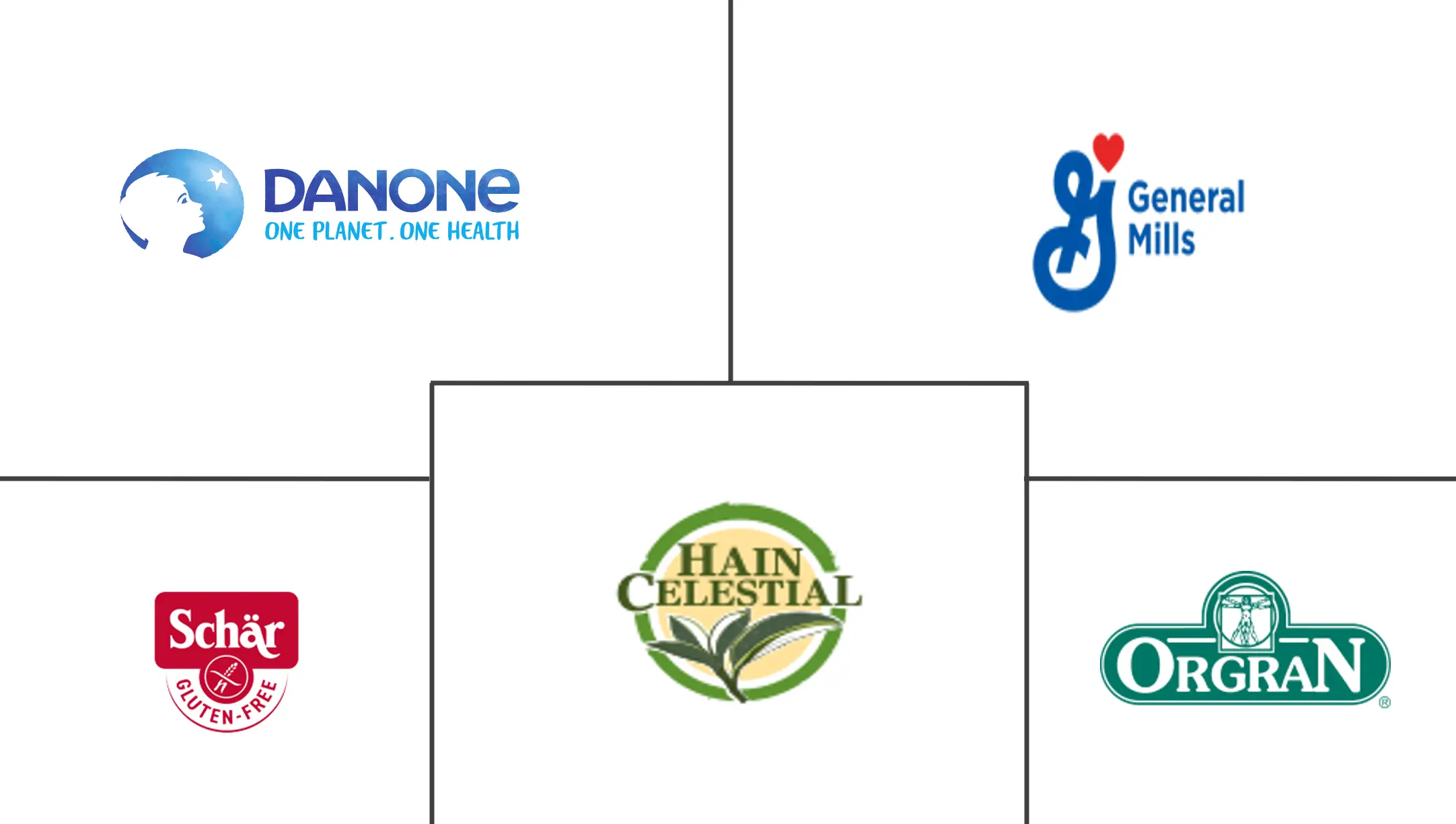Market Size of Middle East and Africa Free-From Food Industry

| Study Period | 2019 - 2029 |
| Base Year For Estimation | 2023 |
| Forecast Data Period | 2024 - 2029 |
| Historical Data Period | 2019 - 2022 |
| CAGR | 8.00 % |
| Market Concentration | High |
Major Players
*Disclaimer: Major Players sorted in no particular order |
MEA Free-From Food Market Analysis
The Middle East and Africa free-from food market is forecasted to witness a CAGR of 8.00%, during the forecast period (2020 - 2025).
- The free-from food products have a significant scope to expand in the region. The retailers in the region generally operate in the low-margin environment. The local and expat population in the region are becoming highly aware of free-from food products, as well as the potential role of these products in a balanced diet and ensuring good health, which is expected to drive a significant growth in the market, over the forecast period.
- Moreover, a major portion of the Middle East & African population is lactose intolerant. Soy-based dairy alternative, followed by rice- and coconut-based dairy alternatives dominate the market. The aforementioned factors, coupled with the rising consumer preferences to maintain a healthy diet, are driving the growth of the free-from food products in the region.
- However, the comparatively high prices of free-from food products pose a challenge to the market. The presence of nutritionally-equivalent alternatives for a lower price affects the consumer behavior and refrains the purchase of free-from food products.
MEA Free-From Food Industry Segmentation
The Middle Wast and Africa Free-From-Food market is segmented by type into gluten free, dairy free, allergen free and other types, by end product into bakery and confectionery, dairy free foods, snacks, beverages, and other end products, by distribution channel into supermarkets/hypermarkets, online retail stores, convenience stores and other distribution channels.
| By Type | |
| Gluten Free | |
| Dairy Free | |
| Allergen Free | |
| Other Types |
| By End Product | |
| Bakery and Confectionery | |
| Dairy Free Foods | |
| Snacks | |
| Beverages | |
| Other End Products |
| By Distribution Channel | |
| Supermarkets/Hypermarkets | |
| Online Retail Stores | |
| Convenience Stores | |
| Other Distribution Channels |
| By Country | |
| South Africa | |
| United Arab Emirates | |
| Saudi Arabia | |
| Rest of Middle East and Africa |
Middle East and Africa Free-From Food Market Size Summary
The Middle East and Africa free-from food market is poised for significant expansion, driven by increasing consumer awareness and demand for healthier dietary options. The region's population, including both locals and expatriates, is becoming more conscious of the benefits of free-from food products, which are seen as essential for maintaining a balanced diet and good health. This growing awareness is particularly evident in the demand for soy-based, rice-based, and coconut-based dairy alternatives, as a substantial portion of the population is lactose intolerant. Despite the high prices of these products posing a challenge, the market is supported by the trend towards clean-label ingredients, which are natural, organic, and minimally processed, appealing to consumers seeking simple and natural food options.
In the United Arab Emirates, the market for gluten-free and allergen-free products is expanding, with international brands and regional players like Areej Jomaa emerging to meet the demand. The online retail sector is also growing, with platforms such as GlutenFree-Supermarket.ae offering a wide range of gluten-free products. The market is highly competitive and fragmented, with a strong presence of private label brands and key players like Dr. Schär AG/SpA, Hain Celestial, General Mills, and Danone SA. These companies are focusing on expanding their presence in emerging economies, leveraging rising income levels and increased knowledge about healthy eating to cater to the needs of the population.
Middle East and Africa Free-From Food Market Size - Table of Contents
-
1. MARKET DYNAMICS
-
1.1 Market Drivers
-
1.2 Market Restraints
-
1.3 Porter's Five Forces Analysis
-
1.3.1 Threat of New Entrants
-
1.3.2 Bargaining Power of Buyers/Consumers
-
1.3.3 Bargaining Power of Suppliers
-
1.3.4 Threat of Substitute Products
-
1.3.5 Intensity of Competitive Rivalry
-
-
-
2. MARKET SEGMENTATION
-
2.1 By Type
-
2.1.1 Gluten Free
-
2.1.2 Dairy Free
-
2.1.3 Allergen Free
-
2.1.4 Other Types
-
-
2.2 By End Product
-
2.2.1 Bakery and Confectionery
-
2.2.2 Dairy Free Foods
-
2.2.3 Snacks
-
2.2.4 Beverages
-
2.2.5 Other End Products
-
-
2.3 By Distribution Channel
-
2.3.1 Supermarkets/Hypermarkets
-
2.3.2 Online Retail Stores
-
2.3.3 Convenience Stores
-
2.3.4 Other Distribution Channels
-
-
2.4 By Country
-
2.4.1 South Africa
-
2.4.2 United Arab Emirates
-
2.4.3 Saudi Arabia
-
2.4.4 Rest of Middle East and Africa
-
-
Middle East and Africa Free-From Food Market Size FAQs
What is the current Middle East and Africa Free-From Food Market size?
The Middle East and Africa Free-From Food Market is projected to register a CAGR of 8% during the forecast period (2024-2029)
Who are the key players in Middle East and Africa Free-From Food Market?
Danone S.A., The Hain Celestial Group, Inc. , General Mills, Inc. , Dr. Schär AG / SPA and Orgran SA are the major companies operating in the Middle East and Africa Free-From Food Market.

